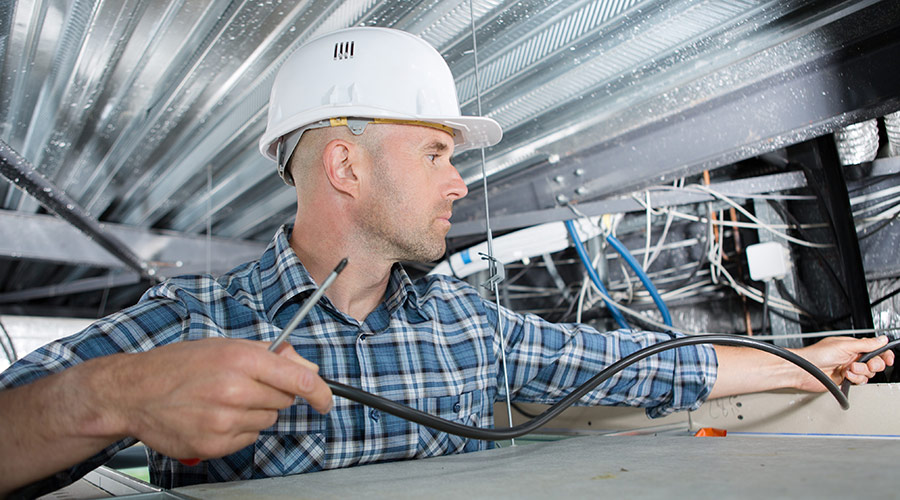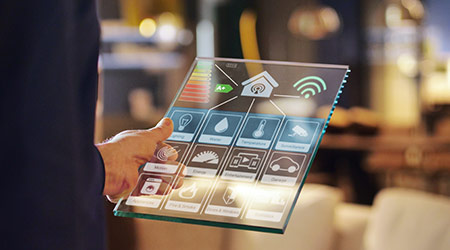SPONSORED
UG2 - Branded Feature
Tackling High Energy Costs Without Breaking the Bank
10 Ways to Boost Energy Efficiency
By James Lane, SVP of Operations and Maintenance, UG2
Energy is the most expensive line item in any facility budget. That’s why keeping gas, electric, water, and diesel fuel costs in check has always been a top priority for building management and owners. And now, with COVID-19 lowering occupancy levels and impacting property revenue, finding ways to reduce energy costs is more urgent than ever.
The downtime stemming from low occupancy presents an excellent opportunity to re-examine your energy consumption strategy. By coupling budget-friendly, easy-to-implement measures with the tax credits, incentives, and rebates available for bigger projects, you can tackle energy efficiency without breaking the bank – and be in a much better position when more people return to offices, schools, retail spaces, and entertainment facilities.
10 Ways to Boost Energy Efficiency
Some of these strategies may be new to you, or perhaps you are doing some already. It is recommended that all of these should be on your list of measures to (re)consider.
- Replace old lighting. The simplest and fastest place to begin is with the lowest-hanging fruit: lighting. Replacing old fluorescent tubes, metal halide, halogen or incandescent lamps with LED lights is relatively low-cost and has a comparatively short payback. LED fixtures consume much less power. They also last longer – 5 to 7 years vs. 2 to 4 years for standard F40 lamps – and don’t require ballasts. This saves money both in capital expenditures and labor. Plus, you get the added bonus of LED’s brighter lighting, which makes facilities look sharper and cleaner.
Changing just a few bulbs won't make much of a difference. However, with hundreds and possibly thousands of bulbs throughout a facility, you can make a significant impact on energy efficiency and electric bills. It’s also important to note that many utility providers offer rebates or incentives to offset your installation costs.
- Install occupancy sensor lighting controls. In areas that are only occasionally utilized, such as storage rooms, bathrooms, emergency stairways, and unused office spaces, keeping the lights on at all times is an energy drain, but having them off can be a safety hazard. Installing occupancy sensor-controlled lighting can solve both issues.
- Adopt lighting control systems. Lighting control systems are smart solutions that go a step beyond motion detectors. They determine how much light to provide in a given area according to current headcount and people movement.
They can also calculate how much natural light is coming in through windows. Light filtering shades filter out heat and allow light in. Based on the position of the sun and solar loads, shades automatically go up or down. They save electric costs by using more natural lighting. By closing shades and stopping thermal load from dissipating into the space, they save on cooling costs as well.
- Install Variable Frequency Drives (VFDs). After lighting, VFDs are often the next major focus for energy savings. They enable you to vary the amount of frequency and voltage for a power supply to a motor, pump, or chiller, so you don’t have to run them at 100%. A VFD also has the capacity to control the ramp-up and ramp-down during start up and shut down, respectively. By linking VFDs to demand, based on space allocation and occupancy, you can make a huge dent in power consumption. Make sure you evaluate VFDs for use on all major pieces of equipment, particularly large central systems like water pumps, boilers, air handlers, and chillers. Chillers can cost hundreds of thousands of dollars in energy costs on a monthly basis if not run efficiently and maintained properly.
VFDs and space allocation analyses can also be used for building system recommissioning, for example, with schedule optimizations. With the right controls and programming in place, equipment that is currently running for 10 or 12 hours may be able to run for six or eight hours and still deliver the results you need.
- Use battery-powered or low voltage, motion-sensor triggered flushometers. They release a metered amount of water and then close back up. Flushometers use less water per flush in a toilet than a typical tank system because they cleanse the bowl with a lower-volume, higher-pressure stream. They ensure that people washing their hands in bathroom sinks don’t let the faucets run too long. They also have self-charging batteries, so you're not adding to maintenance costs. Importantly, the touchless appliances provide a higher level of health and safety by help mitigating the spread of contagious diseases.
- Take advantage of free cooling in the winter. Many buildings operate chillers year-round. However, if your facilities are in colder climates, such as in the Northeast and MidAtlantic U.S., you can use air-to-air or water-to-air heat exchanges, or modulated outdoor cool air during the winter months. This step saves energy costs, reduces maintenance, and prolongs the life of the equipment.
- Use reclaimed or recycled water. Rain collection or harvesting systems can lower energy costs by using “blue water” for non-potable cases such as irrigation and toilet flushing.
- Make sure you have load optimization. Most commercial buildings have three-phase power, but many building owners don’t consider balancing the phase load of their facility. For example, if your heavy equipment is primarily located on the first two floors of an eight-floor building on Phase A, you’ll be burning more energy on that phase than on Phases B and C. By moving some equipment to other floors and phases, you will pull less electricity, balance your phasing, and save money.
- Switching to high efficiency equipment, such as gas- or oil-fired condensing boilers, can save building owners a lot of money. For instance, high efficiency heat recovery or condensing systems burn fuel at 90-98% efficiency compared to 75-80% efficiency. The main difference is that a condensing boiler extracts additional heat from the waste gases by condensing this water vapor to liquid water, thus recovering its latent heat of vaporization. The production of condensate also requires the installation of a heat exchanger condensate drainage system. In a conventional noncondensing boiler, much of this heat is lost through the stack, chimney, or vent pipe.
- Use direct digital controls (DDC) or building automation systems. They turn systems on and off by demand instead of relying on time clocks. For instance, sensors might record an average building temperature of 72 degrees when a building opens at 6:00 am. If, at 8:45 am when occupancy is higher and lights are on, the temperature rises to 74 degrees, the DDC can automatically turn on the cooling system. By not running the cooling system during those 2 ¾ hours, the facility saves several thousand dollars.
A DDC system also provides for tighter (smart) control and determines when a valve, damper, or motor needs to perform a function and at what capacity. It also enables remote access to the building equipment, saving time and cost, and often eliminating the need to dispatch a service provider.

Tax Credits and Rebates
Before embarking on energy-saving projects, you need to make sure your return on investment is worth the upfront time and money. This answer is partly determined by whether the building owner plans to sell the facility within a certain time period, and whether marketing the building as more energy efficient will help with the sale or attract more tenants to lease space.
Generally, a good rule of thumb is to break even on big equipment replacements in two to five years, and on LED upgrades within two years. Local utility companies can help you figure out payback periods by doing load calculations, examining your existing utility bills, analyzing current spend, and projecting future costs for new equipment.
Rebates and tax credits can go a long way towards improving ROI and justifying projects. For instance, LED upgrades not only come with rebates but also can help with reimbursement for the labor involved in replacing fixtures. Solar projects can be done at no cost since many times solar companies install for free and panels don’t require much maintenance. And then, of course, you gain revenue from the solar power harvested by your utility company.
Energy Audits
While many facility managers have a sense of how to improve their energy efficiency, it’s impossible to know exactly what should be done without doing a complete energy audit. A thorough audit can uncover issues with insulation, air exchange, and underperforming equipment, and identify energy conservation measures to drive further efficiencies.
An energy audit enables you to be very strategic in how you operate buildings. You can determine, for example, which equipment should still be maintained and which equipment you should run-to-fail and eventually replace, using offsets from your utility provider, while setting aside money that would have been spent on maintenance for other projects.
These audits should be conducted every three to five years or when it’s clear something major is ‘off.’ They can save you hundreds of thousands of dollars, just like a UG2 customer who didn’t even have to spend a dollar to realize significant savings.
Spending Nothing and Saving More
An energy audit for a higher education customer helped identify the fact that energy costs for a recently constructed building were almost 50% higher than originally modeled. Our team reviewed all energy and engineering functions, including HVAC systems, hours of operation, occupancy, and sequence of operations. After evaluating the facility from bottom to top, the team identified 25 energy conservation measures that could reduce energy usage, including the addition of heat resets via a building automation system, installing occupancy sensors, and running the building only when students were there instead of 24x7.
The cost to implement these changes was $65,000. However, after showing the local utility vendor the projected energy reductions, the provider committed to funding the entire $65,000. Not only did our customer not have to pay for any of the changes, they saved approximately $185,000 in energy costs in the first year alone.
Bottom line? There’s always an opportunity to be more energy efficient and realize greater cost savings. And you don’t have to spend a tremendous amount of money to do so.
You can start by simply researching the technology innovations available today. Find out what your competitors are using. Get demonstrations on equipment that looks promising. Call in energy experts and pick their brains – or ask for a consultation. With this knowledge in hand, you can take the actions best suited to reducing your facility’s energy costs.
Learn more

 James Lane is a seasoned industry executive with extensive expertise in the facilities services space. His career has spanned over two decades and across a wide range of industries. In 2018, he joined UG2 as a Senior Vice President who is responsible for leading all of the company’s Operations and Maintenance teams nationally.
James Lane is a seasoned industry executive with extensive expertise in the facilities services space. His career has spanned over two decades and across a wide range of industries. In 2018, he joined UG2 as a Senior Vice President who is responsible for leading all of the company’s Operations and Maintenance teams nationally.











 James Lane is a seasoned industry executive with extensive expertise in the facilities services space. His career has spanned over two decades and across a wide range of industries. In 2018, he joined UG2 as a Senior Vice President who is responsible for leading all of the company’s Operations and Maintenance teams nationally.
James Lane is a seasoned industry executive with extensive expertise in the facilities services space. His career has spanned over two decades and across a wide range of industries. In 2018, he joined UG2 as a Senior Vice President who is responsible for leading all of the company’s Operations and Maintenance teams nationally.